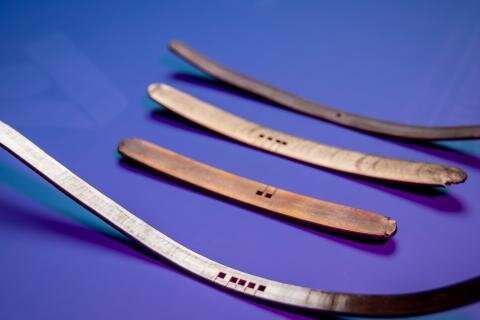Researchers develop a new process for manufacturing permanent magnets

Researchers from the Critical Materials Institute, a U.S. Department of Energy Innovation Hub led by Ames National Laboratory, have developed a new method for manufacturing high-performance permanent magnets.
This new “Hot-roll Nano Neo Magnet” process produces a nanograin neodymium permanent magnet encased in stainless steel in a simple, commercially scalable process. This process is semi-continuous, compared to the batch processes currently used in industry, which makes it more cost and energy efficient.
Neodymium iron boron (Neo) permanent magnets are increasingly important for a variety of technologies, including wind turbines, electric cars, and cell phones. In many applications, permanent magnets need to function in high temperatures. Unfortunately, even moderate temperatures around 150°C (302°F) degrade the performance of the permanent magnets.
According to Jun Cui, a scientist at Ames Lab, the biggest challenge of creating permanent magnets is increasing their resistance to demagnetization at high temperatures. He explained two ways to address this challenge. The first is to add dysprosium to the Neo magnet. However, dysprosium is listed as a critical material by the DOE and many other countries, which means it is available in very limited supply. The second way is to manufacture magnets that have small grain sizes by beginning the manufacturing process with much smaller particles of the magnetic material.
Cui explained, “There are two traditional ways of making magnets. One is you make a lot of powder of a particular size, three microns to five microns, that’s typically the size. And those powders are terribly air sensitive. It is so sensitive that it can light itself on fire, so you have to handle everything with care.” The second involves beginning with powders that are smaller, rather than being measured in microns they are measured in nanometers. For reference, a human hair is typically 70 microns in diameter, and one micron is equal to 1,000 nanometers.
The micron size powders are exposed to a magnetic field to make the magnetic poles of each of the particles point in the same direction, then compacted. Afterwards, they are fused together into a single solid, fully dense material. For a Neo magnet containing dysprosium, the sintering process involves heating the material to extremely high temperatures to densify the magnet.
For the nanoparticle method, the powders do not contain any dysprosium, but must be packed extremely tightly to begin with, then it goes through two phases of hot deformation to densify the magnet. Once these magnets are formed, they are still air sensitive, so they go through a final coating process where they are coated with nickel.
The new method Cui and his team developed simplifies the process. “We end up just starting out as powders and then we pack them into a stainless-steel tube. We pack them really dense and then we just hot roll them,” Cui explained. “We heat it up and then send it to the rolling mill and then the whole thing just goes.”
Cui mentioned several benefits of this new process. First, it does not require a vacuum furnace to protect the magnet materials from the air, because the stainless-steel tube is completely sealed. Second, they can make thinner magnets that maintain their structural integrity and magnetic properties. Third, it eliminates the coating step, since the materials remain in the stainless-steel casing throughout the process. Finally, instead of a batch process, “We can make very long magnets continuously, which can be sliced into numerous smaller magnets,” Cui said. “So now you are suddenly looking at a completely new way of making magnets that is cost effective.”
Citation:
Researchers develop a new process for manufacturing permanent magnets (2023, June 23)
retrieved 23 June 2023
from https://techxplore.com/news/2023-06-permanent-magnets.html
This document is subject to copyright. Apart from any fair dealing for the purpose of private study or research, no
part may be reproduced without the written permission. The content is provided for information purposes only.
For all the latest Technology News Click Here
For the latest news and updates, follow us on Google News.
